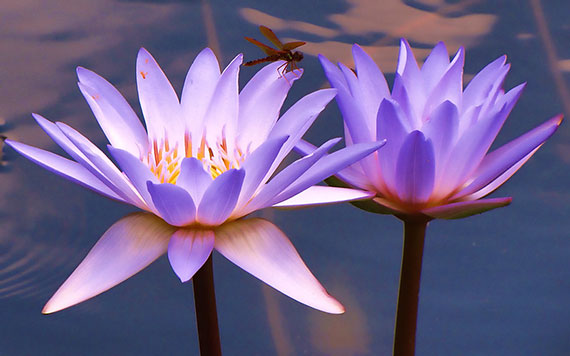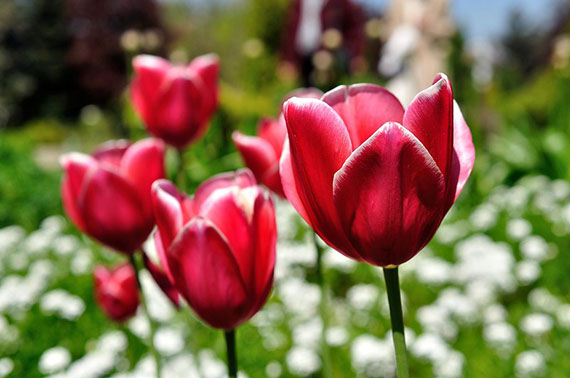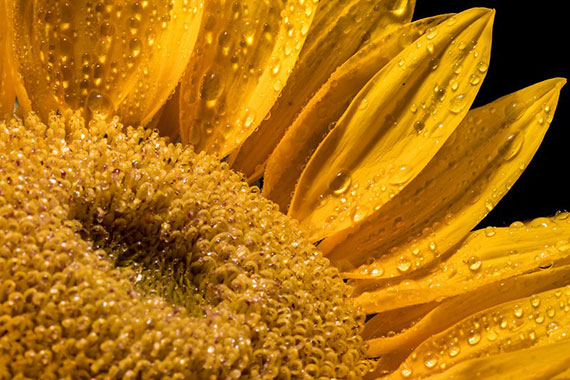When you first discover how to take photos of flowers it can give you many days of wonderful enjoyment. Flower photography is a favorite type of photography that many people love. It’s not difficult to take photos of flowers if you get all the key elements right. If you don’t have any close to you, or you do not have a garden of your own, then try a nursery or a park. You’re bound to find many varieties of flowers there.

Photo by Evangelio Gonzalez; ISO 125, f/5.0, 1/640-second exposure.
Light
In my experience as a pro photographer, it’s best to examine your light first. It is best to use soft and filtered light for your photos of flowers. Why? Well, a strong light will reduce detail in the color and the petals. And that’s where the beauty comes from. You must make sure that you bring out the detail as much as possible and that simply won’t happen unless you shoot in soft light. When you make the conscious decision to choose a softer light, you’ll have much better results.
Take the light on a cloudy, overcast day. It works well for flowers because it has a low intensity and doesn’t create strong shadows across your flowers. These cloudy conditions are perfect for taking photos of flowers because there are no awful shadows to reduce the detail and perfection of your flower.
Polarizing Filters
Another great tip for photographing flowers is to use a polarizing filter. The filter darkens everything in your scene once you place it onto the lens. Bright light can cause a loss of detail on your flower because it’s so small and fine. The camera finds it hard to photograph detail in flowers if there’s too much light flooding the petals. Use this filter to darken the light and bring out the detail.
Shutter Speed
Another method for good flower photography is freezing the movement. There is nothing more frustrating than when you have carefully lined up your shot, and the movement from the wind creates out of focus images. This is a common problem. It usually takes place when you’re shooting in low light and using the auto setting. The shutter slows down in overcast light and, as a result, anything moving may not look sharp.

Photo by natlas; ISO 200, f/5.6, 1/1600-second exposure.
Tripod
Keep the camera as still as you possibly can. If you don’t know much about shutter speed, that’s OK, just keep the camera really still. Use a good tripod. This will help a lot. Using a sturdy tripod for gives you more of an advantage to creating create sharper and clearer photos, because the camera is rock steady.
Depth of Field
The next thing to be mindful of is your sharp focus. Have you ever heard of depth of field? Depth of field just means “the range of what is in focus.” When we photograph flowers we only need a small section of the photograph to be in focus. This is called a shallow depth of field. It means the camera is not “looking” very far. It also means that when you keep your flower in focus you can blur your background. This is a really nice effect. In close up shots of flowers, we don’t need a clear background.
Want your flower photos to be sharp? This is where f stop and aperture come in to play. When you have a narrow aperture (high number f stop) it means you have a greater chance of creating sharper images. What is f stop? F stop refers to your aperture, which is a small opening in your lens that lets light in or reduces it. When you have a smaller opening, the camera is able to sharpen its view, so to speak. Once you get the hang of this try wide apertures (low number f stops) to try to reduce your depth of field and blur out the background. For now, just watch your lighting. That’s the main thing.
Composition
When you place your flowers well, it means you’re getting better with your photographic composition. Your composition is best kept uncomplicated. (That’s why a blurry background works.) To avoid distractions in the background I suggest tightly cropping your flower photographs.
Flower photography works when you have a really good angle. This is also known as “photographic composition”, or just “composition”. This relates to where you deliberately position the interesting things in your photo. You may also like to call it placement of your flower petals.

Photo by John Uhrig; ISO 200, f/32.0, .5-second exposure.
When you zoom right in to get up close to your flower you create a tightly cropped picture. The more you zoom, the more you start working with a smaller area. A smaller area has less light. Less light means a slower shutter or a wider aperture will probably be required. Either way, the closer you get, the more light you need.
Flower photography is the best type of photography, in my opinion. You can make your shots turn out really well if you apply the things I’ve shown you here today. Once you apply good lighting, composition, and technical methods you’ll quickly find you just know how to take photos of flowers easily and quickly.
About the Author:
Amy Renfrey writes for DigitalPhotographySuccess. She is a professional photographer and photography teacher. She shows you how to take the most breathtaking, brilliant, and incredibly stunning photos every single time you press the shutter button, even if you know nothing about photography.
For further training, here is a helpful video on the subject along with more macro instruction:
The video covers timing, lenses, depth of field, focus points, focus modes, and some composition tips for capturing great macro and flower photographs.
Like This Article?
Don't Miss The Next One!
Join over 100,000 photographers of all experience levels who receive our free photography tips and articles to stay current:






Great article on flower photography. My favorite spring flower is the Tulip. I do love my Peak Design travel tripod for capturing the best Macros. Thank you for the insights!
Thank you for a very interesting article on flower photography. I use a Canon 100mm 1×1 macro lens and so far have been very happy with the results. I am not a professional photography but do enjoy doing flower photography.
It was interesting to see that you recommend using continuous focus. I have read a number of articles on the subject of macro photography and they all say that you should use manual focus for the best results.
Also you did not mention shutter speed. I realise that this is subject to the light conditions but noticed in your video the flowers were moving in the breeze yet your images appeared to be sharp.
thanks your post very good
Hi Greg, I thoroughly enjoyed your video on Macro shooting of flowers. With regards to the continuous focus setting, is that the little button displaying the L {for lock I would imagine?} in my case this is situated at the back of Nikon D90 just above the {info} button.
I have experienced those focusing problems on many occasions, but have also got many great photos with my flowers, & thought when you spoke of the “NEW” Macro 105mm VR Nikon lens, maybe I should invest in a better lens.
The lens I am using for my flower shots, is one of 2 that came in the purchase of my Nikon D90, that being an 18-55mm 3.5- 5.6F. What do you think, & where would be the best online store I can purchase one coming from Australia.
Cheers Greg, & I look forward to hearing what your thoughts on the matter are.
John